When it comes to roof repairs, one of the most overlooked aspects is whether a building permit is required. Many homeowners assume they can fix minor roofing issues without involving the local building department.
While that may be true for small repairs, some projects legally require a permit to ensure compliance with building codes and safety regulations. A permit for a minor roof repair depends on local regulations, the scope of the work, and the materials used.
Generally, small repairs like patching leaks or replacing a few shingles might not require a permit. However, it's essential to check with your local building department to ensure compliance with specific regional regulations. Let's look at whether to look for a Permit for a Minor Repair on your roof.
When planning a roof repair, it’s important to understand the role of building permits. Many homeowners and property owners may overlook this step, assuming that minor repairs don’t require permits. However, depending on your location and the extent of the work, obtaining the proper permits is often necessary to ensure compliance with local building codes.
Failing to secure a permit when required can lead to fines, delays, and even the need to redo the work. Building permits are put in place to regulate construction and ensure safety.
Roof repairs involve structural elements, which can impact the overall integrity of your home or building. Whether you’re replacing shingles, fixing a leak, or making more extensive repairs, knowing when a permit is needed can save you from costly mistakes.
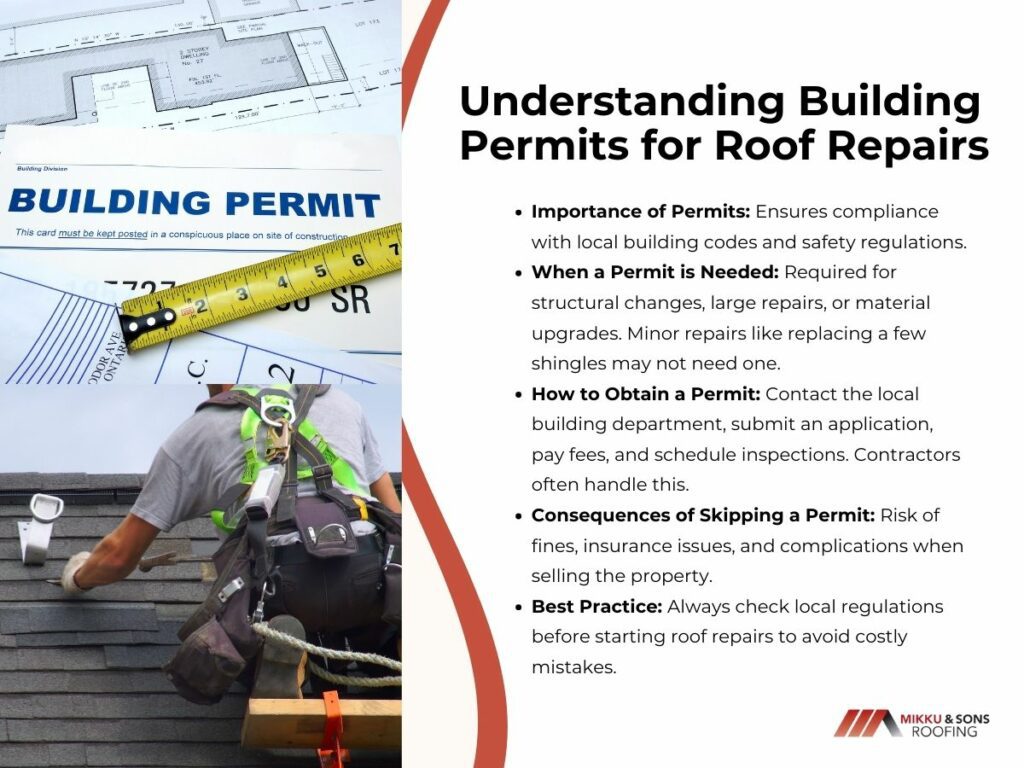
Not all roof repairs require a permit, but there are certain situations where one is necessary. The need for a permit depends on the following:
Before starting any roofing project, it’s best to check with your local building department to determine if a permit is needed.
If a permit is required for your roof repair, the process is relatively straightforward:
If you hire a licensed contractor, they will often handle the permit process for you, ensuring that everything is completed correctly.
Skipping the permit process may seem like a way to save time and money, but it can lead to serious issues:
Planning ahead and contractor scheduling for permit submittals and inspections can help you avoid delays and ensure work begins on time.
Not all roof repairs require a permit, especially if they are minor and do not affect the structural integrity of the roof. Generally, the following types of roof repairs can be performed without obtaining a permit:
Repairs that don’t compromise the roof’s overall structure often don’t require permits. These include:
Since these repairs involve minimal work and do not alter the underlying framework, they are often considered routine maintenance.
If a storm or strong winds have removed a handful of shingles, you can typically replace them without a permit. However, if the repair involves a large section of the roof or changing the material, a permit may be required.
Many local building departments allow homeowners to make small repairs—often under 100 to 200 square feet—without a permit. However, the exact square footage varies by location, so it’s always best to check with your municipality.
Cosmetic work, such as painting, cleaning, or applying a protective roof coating, does not require a permit. These tasks do not impact the roof’s integrity or alter the structure, making them exempt from permitting requirements.
General maintenance, such as cleaning gutters, removing moss or debris, and reapplying caulking, typically does not require a permit. These tasks help extend the lifespan of your roof but do not involve structural changes.
Although these repairs generally don’t require a permit, always verify with your local building department to ensure compliance with regional regulations. Different cities and states have varying rules, and what’s permissible in one area may require a permit in another.
While minor fixes may not need a permit, larger repairs or modifications almost always do. You will likely need a permit for:
Failure to obtain a permit when required can result in fines, delays, and even forced removal of completed work.
If your roofing project requires a permit, the process is usually straightforward but requires careful attention to detail.
Each city and county has its own set of building codes that determine when a permit is necessary. Before starting your project, check your local building department’s website or visit in person to understand the requirements.
Once you confirm a permit is needed, the next step is to complete the application process. This typically involves:
Creating a centralized job folder for your repair project; including permit applications, inspection checklists, photos, and specs; helps you stay organized throughout the process.
Some municipalities require a consultation or pre-approval before issuing a permit. This may involve meeting with an inspector or building official to review your plans and ensure they meet code requirements.
Permit approval times vary, ranging from a few days to several weeks, depending on the complexity of the project. Once approved, the permit must be displayed on-site for inspection purposes.
Most roofing permits require at least one inspection. An inspector may check:
Skipping inspections can result in penalties or requiring work to be redone, leading to increased costs and delays. Accurate field time-keeping helps both homeowners and crews track work progress and hours spent on inspections and repairs, particularly when dealing with permit conditions.
Skipping the permit process may seem like an easy way to save time and money, but it often leads to serious consequences.
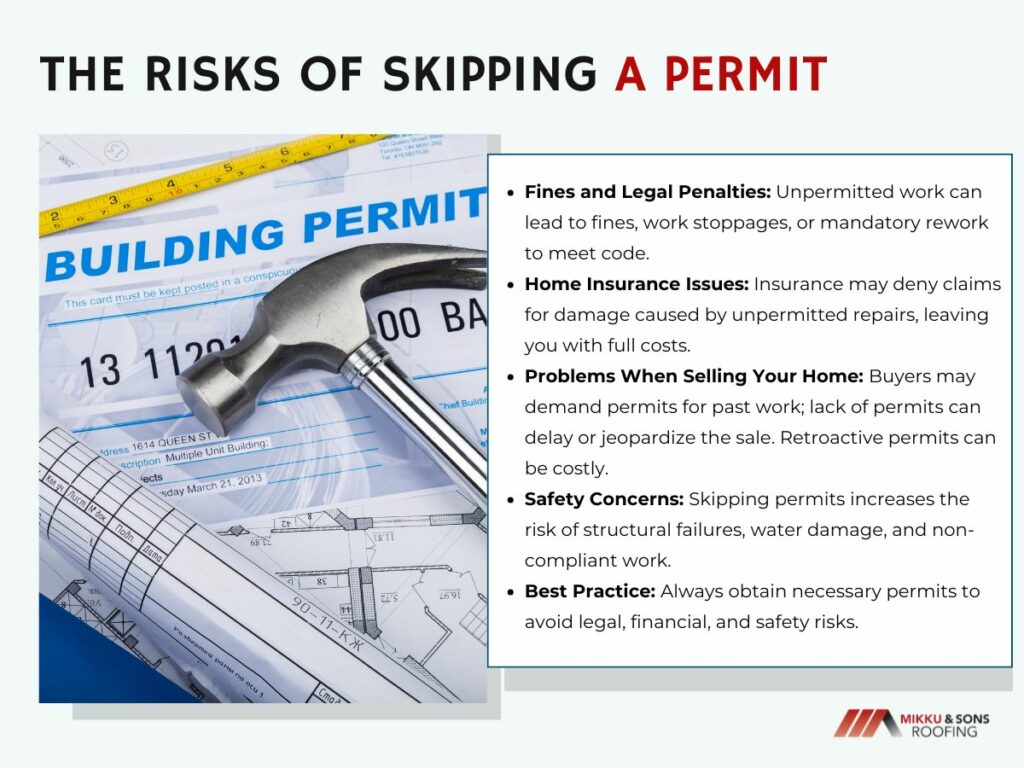
If a building inspector discovers unpermitted work, you could face hefty fines or be forced to stop the project until a permit is obtained. Some municipalities may even require you to remove and redo the work to ensure compliance.
Many insurance companies do not cover damages caused by unpermitted work. If your roof suffers damage due to improper repairs, your claim may be denied, leaving you responsible for the full cost of repairs.
When selling a home, unpermitted work can create major issues during a buyer’s inspection. Buyers may request permits for previous repairs, and if none exist, it can delay or jeopardize the sale. In some cases, homeowners must obtain a retroactive permit, which can be costly and time-consuming.
Permits exist to ensure that roofing work is completed safely and according to code. Skipping this step increases the risk of structural failures, water damage, and other costly issues that could have been avoided with proper inspections.
If you're unsure whether your roof repair requires a permit, it's best to consult a professional. Architects, contractors, and roofing specialists have experience navigating local regulations and can help:
Hiring a licensed professional ensures your roofing project is done legally, safely, and without unnecessary delays.
Navigating Arizona's roofing permit requirements is crucial for any roofing project. Whether it's a full replacement, structural repair, or material change, a permit is often necessary to ensure compliance with local building codes.
While minor repairs might not require a permit, consulting with your local building department is always a good idea. Failing to obtain the necessary permit can lead to financial penalties, liability issues, and project shutdowns.
Engaging with an experienced roofing contractor can help you navigate this process, ensuring your project adheres to all regulations and avoids potential pitfalls.
Your roof protects you from harsh weather, helps with energy efficiency, and plays a big role in your home’s overall value. If you’re thinking about replacing or upgrading your roof, you might have come across spray foam roofing as an option.
But before making a decision, you probably want to know one thing—how much does foam roofing cost, and is it worth it? Foam roofing isn’t the cheapest option upfront, but its durability, insulation benefits, and long-term savings make it a strong contender.
A foam roof is sprayed on as a liquid, expanding into a solid, lightweight, seamless layer that keeps water out and heat from escaping. That sounds great, but does it justify the price?
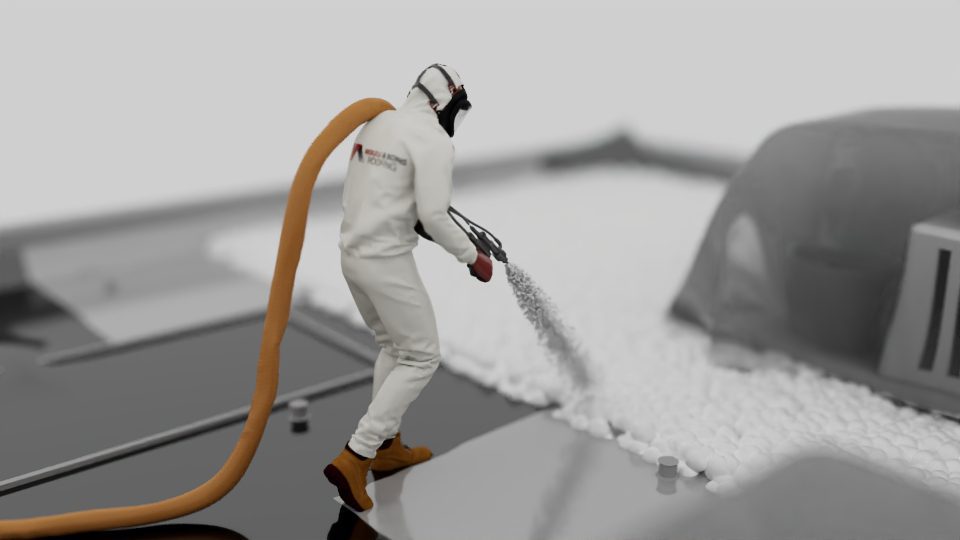
If you have a flat or low-slope roof, spray foam roofing might have caught your attention. It is not as common as shingles or metal roofing, but it has some unique benefits that could make it a better choice for your home.
Foam roofing, also known as spray polyurethane foam (SPF) roofing, is a system that starts as a liquid and quickly expands into a thick, protective layer. This foam forms a solid surface that covers your entire roof without seams or joints, which makes it different from materials like shingles or membranes.
Once applied, it hardens into a waterproof barrier that also provides insulation, helping to keep indoor temperatures stable. A protective coating is added on top of the foam to shield it from sun exposure and weather damage.
This coating is usually made of silicone or acrylic and plays a big role in extending the roof’s lifespan.
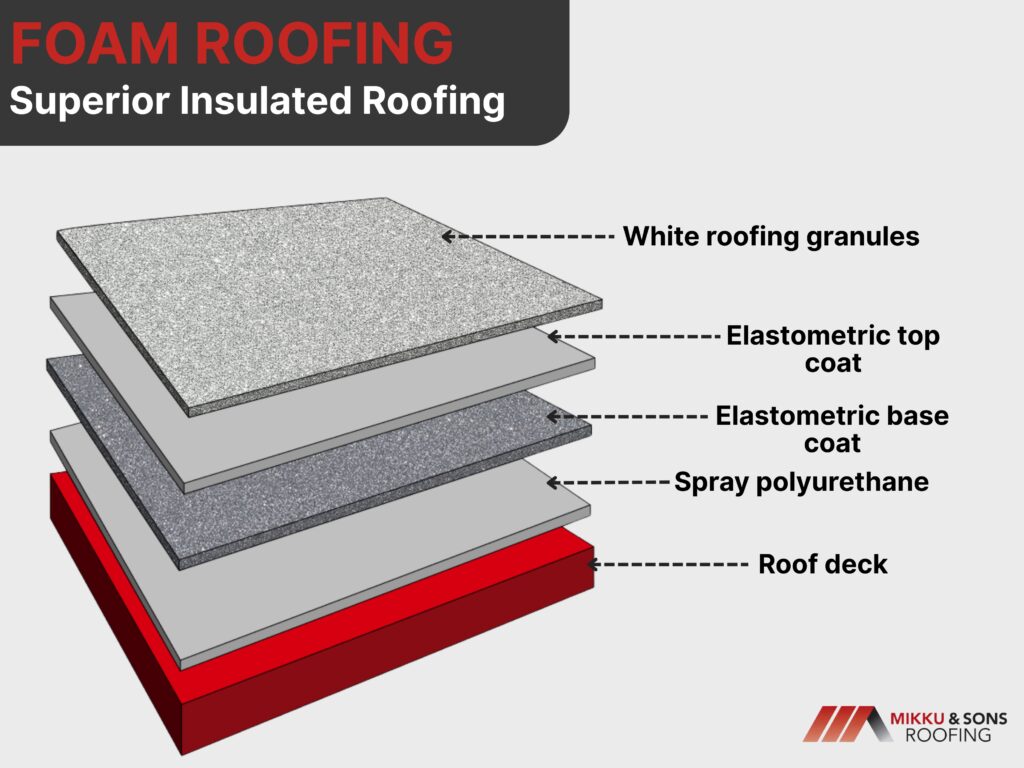
The thick layer of insulation helps to keep heat inside during winter and blocks heat from getting in during summer. This can lower energy bills and make your home more comfortable year-round.
Because foam roofing does not have gaps or seams, it also reduces the chance of air leaks, which can make heating and cooling systems work harder than they need to. A foam roof is completely seamless meaning fewer chances for leaks, especially in areas where heavy rain is common.
If your home has an older flat roof that tends to collect water, foam roofing can also be applied with a slight slope to improve drainage.
When planning a roofing project, cost is often the biggest factor in deciding which material to go with. The price can vary depending on several factors, including the size of your roof, the amount of prep work required, and local labor rates.
The unique application process of foam roofing means that installation is not as straightforward as rolling out a sheet of material. The complexity of the job, along with the skill required to apply the foam evenly, plays a big role in the final cost.
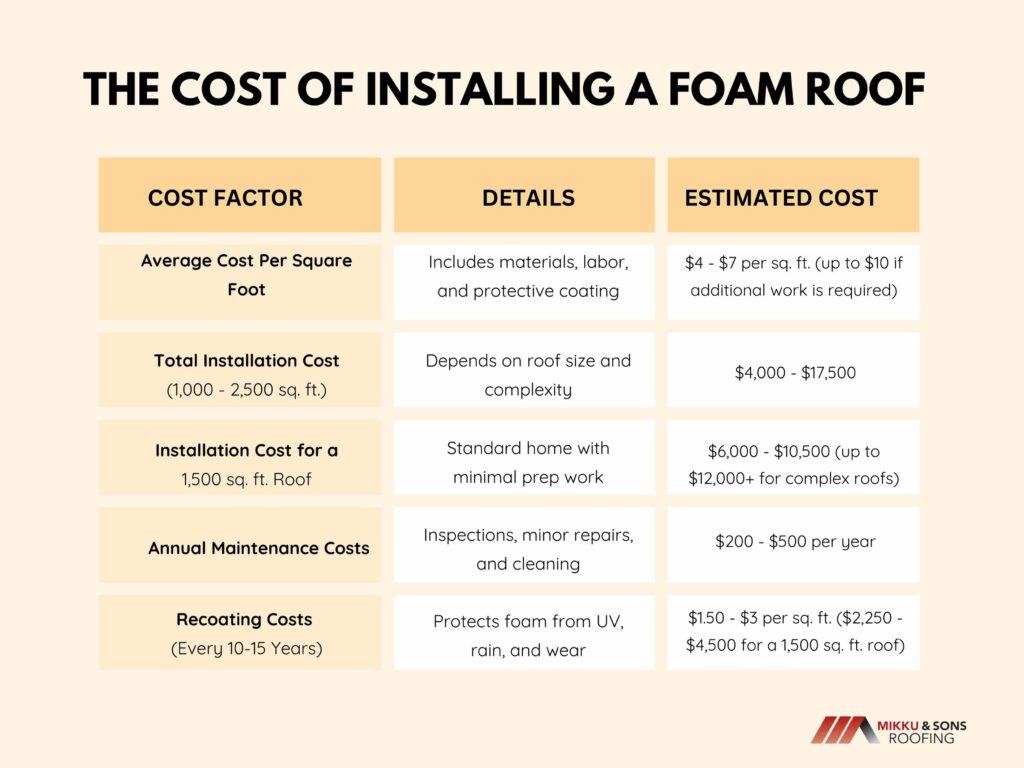
Foam roofing installation typically costs between $4 and $7 per square foot. This includes the materials, labor, and the protective coating applied on top of the foam.
Since most residential flat roofs range from 1,000 to 2,500 square feet, a full installation can cost anywhere from $4,000 to $17,500, depending on the roof size and complexity. If your roof has multiple slopes, skylights, or existing damage that needs to be repaired before applying the foam, the price can go up.
In some cases, homeowners pay closer to $10 per square foot when additional work is required.
For a 1,500-square-foot roof, which is common for many homes, you can expect to pay around $6,000 to $10,500 for a foam roofing installation. This estimate includes everything from surface preparation to the final protective coating.
If your roof is in good condition and requires minimal prep work, you may end up on the lower end of the price range.
On the other hand, if your existing roof has water damage, old layers that need to be removed, or requires structural reinforcement, the total cost can be higher. It can cost closer to $12,000 or more for a more complex installation.
Installing a new roof is a big investment, but the costs do not stop once the job is done. Every roofing material needs some level of upkeep, and foam roofing is no exception.
The good news is that when properly maintained, a foam roof can last for decades, saving you money on major repairs and premature replacements. However, ignoring maintenance can lead to expensive problems down the road.
Since foam roofing is seamless and lightweight, it does not require as much maintenance as some other flat roofing materials. However, its protective coating wears down over time, and small cracks or punctures can form if the roof is exposed to debris or heavy foot traffic.
Regular inspections and timely repairs are key to keeping maintenance costs low and extending the life of the roof.
Like any roof, foam roofing needs routine checkups to prevent small issues from turning into big problems. On average, homeowners spend between $200 and $500 per year on foam roof maintenance.
This cost includes professional inspections, minor repairs, and cleaning to remove dirt, leaves, and other debris that can affect the roof’s performance.
If you are comfortable doing some of the basic upkeep yourself, such as clearing debris and checking for visible damage, you can reduce the cost of maintenance. However, hiring a professional at least once a year is recommended to catch potential issues early.
One of the most important aspects of maintaining a foam roof is recoating it every 10 to 15 years. The top protective layer, usually made of silicone or acrylic, helps shield the foam from UV rays, rain, and general wear and tear.
Without this coating, the foam can become brittle and prone to cracking.
This might seem like a big expense, but it is much cheaper than replacing the entire roof.
Skipping maintenance might seem like a way to save money, but it can lead to costly repairs or even full roof replacement much sooner than expected. Some of the most common issues that arise from neglected foam roofs include:
If a foam roof is not properly cared for, a full replacement may be needed much sooner than expected. This can cost anywhere from $4 to $10 per square foot, which adds up quickly for larger roofs. Keeping up with inspections, repairs, and recoating can prevent these issues and save thousands in the long run.
Foam roofing can be a cost-effective choice over time, but only if you are willing to invest in regular maintenance. With proper care, it can outlast many other flat roofing materials and provide strong protection for your home without frequent repairs.
Foam roofing has a lot to offer, but it is not the only option for flat or low-slope roofs. If you are comparing different materials, you might be wondering how foam stacks up against common alternatives.
| Roof Type | Cost per Square Foot | Lifespan (Years) | Key Benefits |
|---|---|---|---|
| Foam Roofing (SPF) | $4 – $7 | 20 – 50 | High insulation, seamless, lightweight |
| TPO Roofing | $5 – $10 | 15 – 30 | Energy-efficient, reflective surface |
| EPDM Rubber Roofing | $4 – $8 | 20 – 30 | Flexible, durable, weather-resistant |
| Built-Up Roofing (BUR) | $3.50 – $7 | 15 – 30 | Multiple protective layers, fire-resistant |
| Metal Roofing | $7 – $12 | 40 – 70 | Extremely durable, low maintenance |
Each of these options has its own strengths, but the right choice depends on your budget, climate, and long-term expectations.
TPO (thermoplastic polyolefin) is a single-ply roofing membrane that is widely used for flat roofs. It is known for its affordability and heat-reflective properties, making it a popular choice for homeowners looking to cut energy costs.
TPO roofing costs between $5 and $10 per square foot, making it slightly more expensive than foam in some cases. It lasts 15 to 30 years, depending on installation quality and climate conditions. Foam can last just as long or longer with proper maintenance.
The seams can weaken over time, leading to leaks. Foam roofing, being seamless, does not have this issue.
EPDM (ethylene propylene diene monomer) is a synthetic rubber roofing material that has been used for decades. It is lightweight, flexible, and resistant to UV damage, making it a reliable choice for flat roofs.
EPDM roofing costs between $4 and $8 per square foot, making it similar in price to foam roofing. It can last 20 to 30 years but may require more frequent repairs due to shrinkage or seam failure.
While EPDM is highly weather-resistant, it can shrink over time, pulling away from edges and seams. Foam roofing does not shrink and remains adhered to the surface.
Built-up roofing (BUR) is a traditional flat roofing system made from multiple layers of tar, asphalt, and gravel. It has been used for over a century and is known for its durability.
BUR costs between $3.50 and $7 per square foot, making it one of the more affordable flat roof options. It can last 15 to 30 years, but it depends heavily on the quality of installation and maintenance.
BUR is heavy and can develop cracks over time. Repairs can be more complex compared to foam roofing.
Every roofing option comes with trade-offs, and foam roofing is no different. Will it actually save money in the long run? Will it last as long as other options? Most importantly, is it worth the investment in my home?
| Pros | Cons |
|---|---|
| Seamless and leak-resistant | Requires professional installation |
| High insulation = lower energy bills | Needs recoating every 10-15 years |
| Lightweight and adheres to any surface | Can be punctured by debris if not maintained |
| Long lifespan with proper upkeep | Higher initial cost than some other flat roofing materials |
The answer depends on what matters most to you.
The thick layer of spray-applied foam provides higher insulation than most other flat roof materials. This means your heating and cooling system does not have to work as hard, leading to lower energy bills year-round.
Some homeowners report saving up to 30% on energy costs, which can add up to thousands of dollars over the lifespan of the roof. Other flat roofing materials, such as TPO and EPDM, rely on seams and adhesives that can break down over time.
The cost of repairing a leaky roof can add up quickly, so avoiding leaks altogether can save a significant amount of money in the long run.
No roof is truly maintenance-free, but foam roofing requires less upkeep compared to many other flat roof options. It needs to be inspected annually and recoated every 10 to 15 years, but the overall maintenance costs are lower than materials like TPO or EPDM, which often require patching and seam repairs.
When making any major investment in your home, the biggest question is whether it will be worth it in the long run. Foam roofing may cost more upfront than some other flat roof options, but it can last for decades, preventing costly leaks.
The key is to take care of it so that it performs the way it is meant to. One of the most important things you can do to extend the life of a foam roof is to keep up with recoating.
Over time, the protective layer on top of the foam wears down due to sun exposure, rain, and other weather conditions. If this layer is not reapplied every 10 to 15 years, the foam underneath can weaken, leading to cracks, leaks, and expensive repairs.
Phoenix has occasional heavy monsoon storms apart from the constant blazing sun. Your roof works to protect your home to prevent roofing damage that may bring about issues like leaks or missing shingles.
Keeping your roof in good shape is one of the most important things you can do to protect your home and everything inside it. Roof repairs fix problems as they come up and save you from any bigger ones.
A small issue could easily turn into a major expense that might warrant a total roof replacement if action isn't taken. If you’re a homeowner in Phoenix, the intense heat, sudden storms, and even dust can damage your roof faster than you might expect.
Living in Phoenix means enjoying warm winters, but it also means dealing with some extreme weather. Your roof takes on the scorching heat, sudden rainstorms, and even the occasional hail.
Monsoon storms, with their heavy rain and strong winds, can also weaken the structure or cause damage.
These weather patterns can push your roof to its limits fast and the desert climate creates conditions that are tough on roofing materials. Prolonged exposure to intense sunlight can cause materials to dry out, crack, or fade.
If you tackle a roof repair with uncertainty of potential costs you'll get surprises down the road or even get stressed. It’s important to have a clear idea of what you might spend so you can plan ahead.
Repair costs in Phoenix vary depending on several factors like the size of the damage and the type of roof you have. It can be tempting to go for the cheapest option but you need to balance quality and affordability.
Roof repairs in Phoenix depend on the type of repair needed. The good news is that not every roof issue requires a massive investment.
For smaller issues like sealing a leak or replacing a handful of shingles, you can expect to pay between $300 and $1,000. The fixes typically involve localized problems that don’t require extensive labor or materials.
Fixing minor cracks in tiles, repairing flashing, or patching up small holes usually falls into this range. If your roof has minor storm damage, like a few blown-off shingles, the cost may stay on the lower end.
Moderate repairs, such as replacing damaged underlayment or repairing larger sections of a roof, often cost between $1,000 and $5,000. More labor and materials are involved, particularly for tile roofs, where multiple tiles may need removal and replacement to access the problem area.
Flat roofs with water pooling issues or damaged membranes can also fall into this category. The repair process may involve re-sealing or adding new layers of material to ensure proper waterproofing, which increases the cost of the job.
Major roof repairs, such as fixing structural damage or replacing large sections, can range from $5,000 to $10,000 or more. These repairs are often necessary when damage has been left unaddressed for an extended period or after natural disasters.
Tile roofs, in particular, may require significant labor for these types of repairs, as tiles must be carefully removed and replaced. If water damage has compromised the roof’s structure, additional costs for framing or decking repairs can drive up the total price.
With roof repairs, the final cost isn't always straightforward because it's influenced by a variety of factors. You also need to focus on the hidden parts of the roof when checking for damage apart from the visible ones.
Small, isolated issues like fixing a single cracked tile or patching a small leak typically cost less. On the other hand, larger problems, such as widespread leaks or damage to the underlayment, require more time and materials.
If your roof has structural issues or water damage that has spread into your home, the repair bill can increase significantly. In such cases, additional work like replacing roof decking or interior repairs may be necessary, adding to the overall cost.
The material on your roof can also impact repair costs.
Roofing repairs are often in higher demand during certain times of the year, such as after monsoon season in Phoenix. During these peak periods, contractors may charge more due to increased demand.
Scheduling repairs during off-peak times can sometimes help you save money. Timing is also important when it comes to addressing damage.
Waiting too long to fix a minor issue can allow it to worsen, leading to more expensive repairs.
If the damage is in a hard-to-reach spot, such as near a chimney or skylight, contractors may need extra time and effort to complete the job. Similarly, steep or multi-level roofs often require additional safety measures, which can increase the price.
While it might be tempting to go with the cheapest option, hiring a skilled professional ensures the repair is done correctly the first time. Poor-quality repairs can lead to more problems, costing you more.
All roofs have unique layouts and materials that impact the repair costs. Some materials are affordable and easy to fix, while others require specialized skills and materials.
Some are built to handle Phoenix's intense heat better than others, but they can still face issues that require attention.
Asphalt shingles are relatively inexpensive to install and repair, with costs for minor fixes typically ranging from $200 to $1,000. Replacing damaged or missing shingles is straightforward, and materials are readily available.
However, asphalt shingles can wear out faster in Phoenix’s intense heat, leading to curling, cracking, or granule loss. If your roof has widespread damage, repairs may become more frequent.
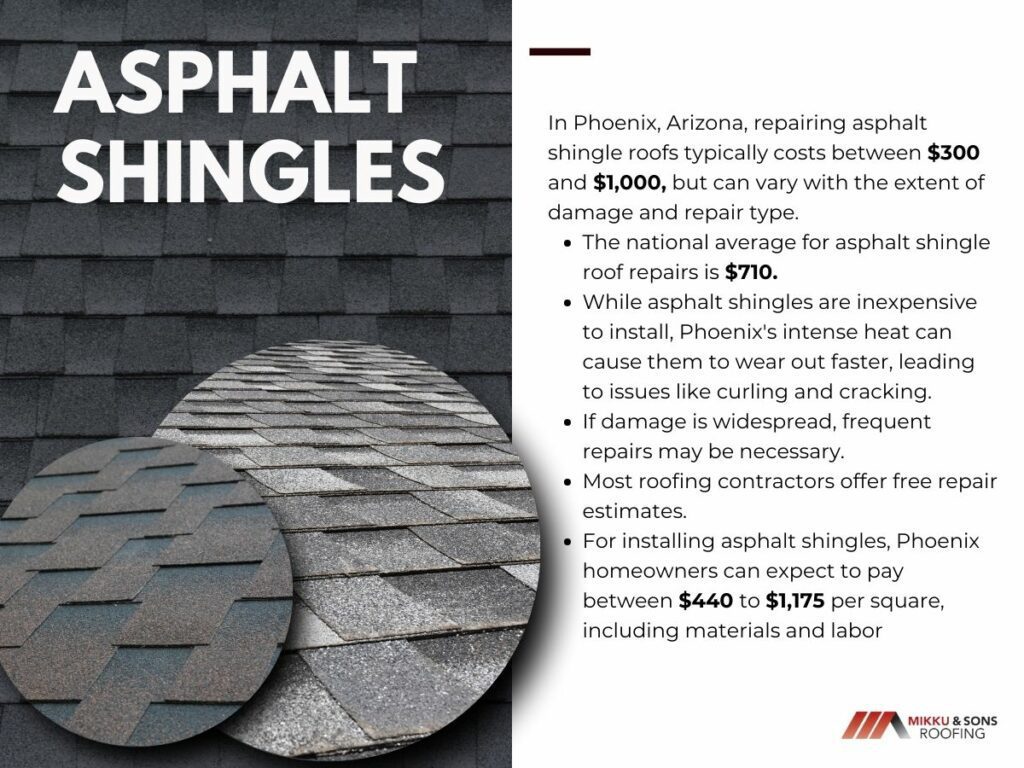
Tile roofs are a common sight in Phoenix due to their ability to handle high temperatures. Repairing tile roofs tends to be more expensive, with costs ranging from $300 to $5,000 depending on the extent of the damage.
The labor-intensive process of working with tiles is a major factor in the higher repair costs. Broken or cracked tiles need to be carefully replaced, and if the underlayment beneath the tiles is damaged, it adds to the expense.
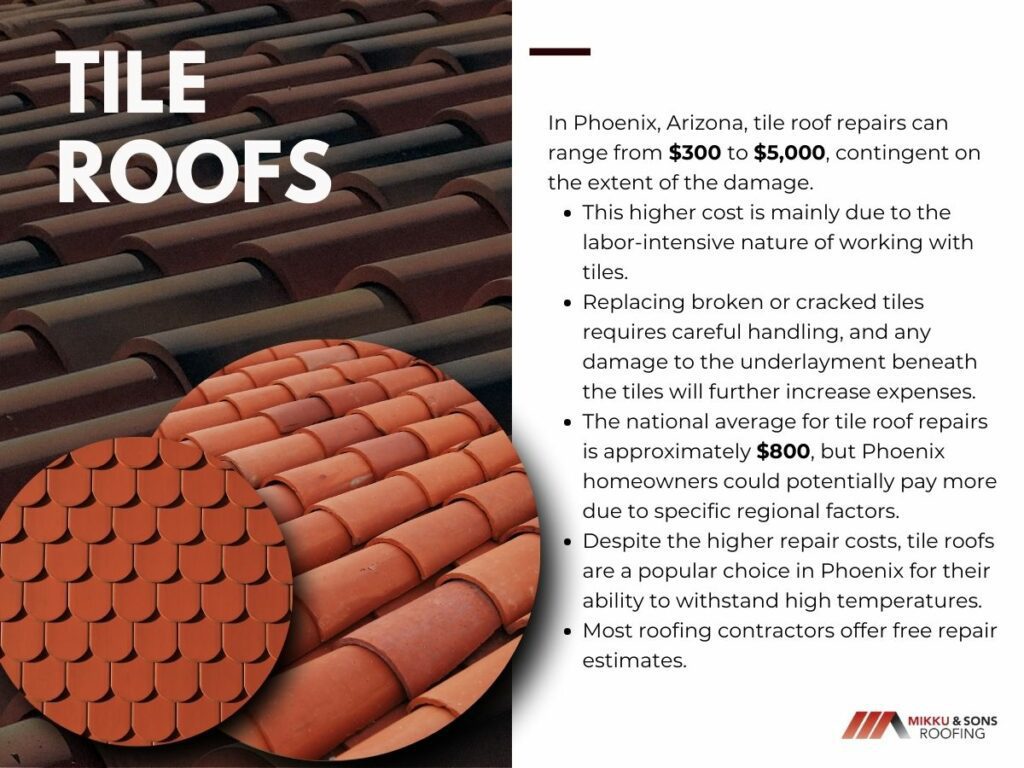
Metal roofs are growing in popularity for their energy efficiency and ability to reflect heat. Repairs for metal roofs usually cost between $500 and $3,000.
Common issues include fixing leaks at seams or replacing damaged panels. Because metal roofs often require specialized knowledge and tools for repairs, labor costs can be higher.
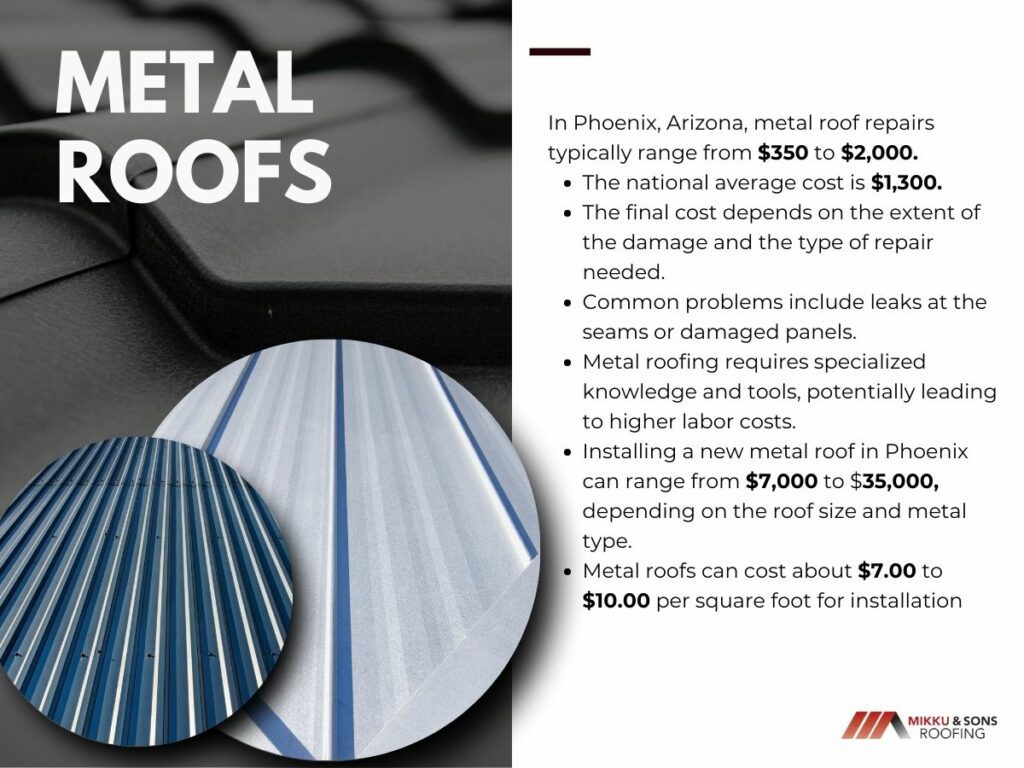
Flat roofs, often found on modern or commercial properties, are another common choice in Phoenix. Repair costs for flat roofs range from $500 to $4,000 depending on the problem.
Issues like pooling water, damaged membranes, or leaks at seams are common repair needs. The materials used in flat roofs, such as modified bitumen or single-ply membranes, require specific techniques to repair.
Your roof won’t always show obvious signs when it needs attention. This is why you need to know early warning signs to help you fix minor issues before they turn into major problems.
Often, small changes in or around your roof can signal the start of a bigger issue.
Start by inspecting your roof for visible damage. From the ground, look for missing, cracked, or curling shingles if you have an asphalt roof.
If your roof is made of tiles, check for chips, cracks, or tiles that appear out of place. For flat roofs, look for sagging areas or signs of water pooling after rain.
Damaged flashing around vents, chimneys, or skylights is another sign your roof may need attention. Flashing is designed to keep water out, and when it’s loose or corroded, leaks can quickly follow.
Your roof’s condition doesn’t just affect the outside of your home. Issues can show up inside as well.
Check ceilings and walls for water stains, peeling paint, or discolored patches. These are often signs of a leak, especially after a rainstorm.
If you notice an unexplained musty smell, it could indicate moisture or mold buildup caused by a roof issue. Look for damp insulation, signs of sunlight streaming through cracks, or areas where wood appears dark or rotting in your attic.
A spike in your energy bill could mean your roof is no longer insulating your home effectively. Damaged insulation, gaps, or poor ventilation can cause your air conditioning to work overtime, leading to higher energy costs.
Pay attention to temperature changes inside your home as well. If certain rooms are hotter or colder than usual, it could be a sign of roof issues that are impacting airflow or insulation.
Your homeowners insurance policy can help you manage costs with roof repairs. The first step is knowing what your insurance covers in terms of roof damage.
Most standard policies will cover damage caused by sudden, unexpected events like a storm or a fallen tree. However, damage from wear and tear, neglect, or lack of maintenance may not be covered.
For example, if a roof leaks because it hasn’t been properly maintained, you might be responsible for the repairs.
If your roof is damaged by a covered event your insurance should help pay for the repair costs, minus your deductible. Depending on the severity of the damage, you may only need a minor repair, or the entire roof may need replacing.
Your insurer will typically send an adjuster to assess the damage and determine what repairs are necessary. It’s important to be aware of your deductible, as it can affect whether filing a claim makes sense financially.
If the repair costs are low, it might be more cost-effective to pay out-of-pocket rather than file a claim. If your roof is nearing the end of its lifespan, insurance might cover only a portion of the replacement cost.
Before you contact your insurance company, it’s a good idea to document the damage thoroughly. Take clear photos of any visible damage and keep notes of the date and circumstances surrounding the event.
If you’ve had regular roof inspections, having a record of these can also help demonstrate that you’ve kept up with maintenance. When you file your claim, be prepared for an adjuster to inspect the damage and provide an estimate.
The adjuster may recommend certain contractors, but you have the right to choose your own roofing professional. If you feel the adjuster’s estimate doesn’t reflect the true cost of repairs, you can get a second opinion from a trusted roofer.
Your roof protects you from the elements while providing safety and comfort. Knowing the common issues your roof might face and addressing them early in Phoenix can help you avoid costly damage.
When repairing a roof, it’s important to decide what you can handle yourself and when it’s time to call in a professional. Patching up a minor issue might seem manageable, but some repairs require experience and specialized tools.
Tackling complex problems on your own can lead to mistakes, which might cost you more. On the other hand, leaving every small task to a contractor could mean unnecessary expenses.
Roofing is a critical component of any home, as it provides protection from the elements and contributes to the overall aesthetic appeal. While there are various roofing materials to choose from, metal roofing has become increasingly popular among homeowners due to its numerous advantages.
However, like any material, metal roofing comes with its own set of drawbacks. This article will explore the pros and cons of metal roofs for your home.
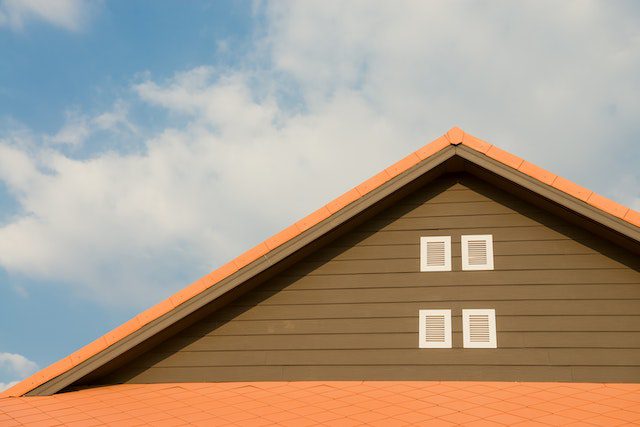
Metal roofs have become an increasingly popular choice as they offer numerous benefits. In fact, metal roofs have emerged as an attractive alternative to traditional roofing materials.
Here are some advantages of metal roofs, providing homeowners with the information they need to make an informed decision.
One of the most significant benefits of metal roofing is its exceptional durability. Metal roofs are resistant to cracking, shrinking, and eroding, making them an excellent choice for long-term use. They can withstand harsh weather conditions, including heavy rain, hail, snow, and high winds.
With proper maintenance, a metal roof can last for 40 to 70 years or more, far outlasting traditional asphalt shingle roofs, which typically last for 20 to 30 years.
Metal roofs are highly energy-efficient due to their reflective properties. They reflect solar radiant heat, reducing the amount of heat absorbed by your home. This can decrease cooling costs during hot summer months by up to 25%, saving you money on your energy bills.
Metal roofs also provide better insulation during colder months, helping to maintain a comfortable indoor temperature and reducing heating costs.
Metal roofs are eco-friendly, made from recyclable materials, and can be recycled at the end of their life cycle. This helps reduce the environmental impact of roofing waste in landfills. Additionally, the energy efficiency of metal roofs can contribute to a smaller carbon footprint for your home.
Compared to other roofing materials, metal roofs require minimal maintenance. They are resistant to mold, mildew, and pests, reducing the need for frequent repairs or replacements. Occasional inspections and cleaning are generally all needed to maintain a metal roof's longevity and performance. This low maintenance aspect can save homeowners both time and money in the long run.
Metal roofs come in a wide range of colors, styles, and finishes, allowing homeowners to select a design that complements their home's architecture and personal taste. Modern metal roofing materials can mimic the appearance of other materials, such as wood shakes, clay tiles, or slate, providing a sleek and sophisticated look. Metal roofing can enhance the overall aesthetic of a home, potentially increasing its resale value.
Metal roofs are non-combustible, making them an excellent choice for fire-prone areas. They have a Class A fire rating, the highest rating available for roofing materials, which can provide homeowners with peace of mind and potentially lower insurance premiums.
Metal roofing materials are relatively lightweight compared to other options like tile or slate. This reduced weight puts less stress on your home's structure, making metal roofs an ideal choice for both new construction and re-roofing projects.
While metal roofs have gained popularity due to their numerous benefits, it's essential to be aware of the potential drawbacks associated with this type of roofing material. With that, here are some disadvantages of metal roofs, providing homeowners with a comprehensive understanding of the potential challenges they may face when choosing this roofing option.
One of the primary drawbacks of metal roofing is the higher upfront cost compared to other materials like asphalt shingles. The investment can be substantial, but it's important to consider the long-term benefits, such as durability, energy efficiency, and low maintenance.
In many cases, the overall cost of ownership may be lower over time, but homeowners must be prepared for the initial expense.
"Our real estate company buys houses in Mishawaka, IN and metal roofs are popluar style there. We have noticed a lot of real estate compnanies that fix and flip properties will install shingle over metal roofs in most cases because of the economics. However, if its your home and you want it to stand out then metal roofs are great in boosting your curb appeal!"
Matt Vukovich | Real Estate Investor in Mishawaka, IN

During heavy rain or hailstorms, metal roofs can be noisier than other roofing materials. The sound of raindrops or hail hitting the metal surface may be distracting or disruptive for some homeowners. However, this issue can be mitigated by installing proper insulation or noise-reducing underlayment during installation.
Metal roofing installation requires skilled professionals with experience in handling the material. Choosing a reputable and experienced contractor for the installation is essential to avoid any potential issues down the line. Improper installation can lead to leaks, poor performance, and reduced lifespan.
Additionally, finding a qualified installer in your area may be more challenging compared to finding an installer for more common roofing materials.
Metal roofs can expand and contract as the temperature changes, which may cause some panels to become loose or warp over time. However, modern metal roofing systems are designed to accommodate these changes, and proper installation can minimize potential issues.
Nevertheless, the expansion and contraction in extreme temperature fluctuations may lead to more significant problems that require repairs or roof replacement.
In the event of damage to a metal roof, repairs can be more complicated and costly than with other materials. In some cases, it may be necessary to replace entire panels rather than repairing small sections. This can make repairs more expensive and time-consuming.
Additionally, finding a contractor skilled in metal roof repair may be more challenging, as it requires specialized knowledge and expertise.
While metal roofs are highly durable, they are not entirely immune to damage. Metal roofs can become dented in extreme cases, such as severe hailstorms or falling debris.
Some types of metal roofing, like aluminum and copper, are more prone to denting than others, like steel. While dents do not necessarily compromise the roof's performance, they can be unsightly and may require professional repair to restore the roof's appearance.
While metal roofs are available in various styles and colors, they may not fit every home's aesthetic best. Some architectural styles, like traditional or historic homes, may not be compatible with the modern look of a metal roof. In these cases, alternative roofing materials may be more appropriate to maintain the home's overall aesthetic.
Metal roofs are an increasingly popular choice for homeowners seeking a durable, energy-efficient, and environmentally friendly roofing option. While the initial cost may be higher than other roofing materials, the long-term savings in maintenance and energy costs can make it a wise investment.
However, it is essential to consider the potential drawbacks, such as noise, installation challenges, and limited repair options. By carefully weighing the pros and cons of metal roofs, homeowners can decide on the best roofing material for their unique needs and preferences. Ultimately, a well-installed and maintained metal roof can provide lasting protection and curb appeal for your home.
It is anticipated that tile roofing should endure a lifetime. Nevertheless, there are situations when it needs to be fixed owing due to leaks caused by slipping, cracking, or sagging, defective flashing, or a worn-out underlayment. Making repairs as quickly as feasible is critical.
Damage gets gradually worse if not corrected. The repair prices and considerations for these materials are distinct from those for other types; if they need to be serviced or repaired, it is essential to have a good hold on them.
Damage could arise from a range of different sources. Wind, ice, debris, hail, and even the sun's heat all cause damage to a roof over time.
When a roof of this type is damaged, it usually only affects a single tile at a time. In most circumstances, you will not have to replace all of the tiles on the roof. Only damaged ones will need to be replaced, but it's always advisable to get an expert opinion to see how bad the damage really is.
In other circumstances, the repair might not even require new tiles. Alternatively, you might have the current tiles repaired. When the tiles are damaged, they can potentially cause leaks, which can, in turn, generate additional damage to the roof. Damage to the building's interior from leaks is also possible and can be expensive to repair.
| Repair cost | Price |
| Material | Composite tiling: $10 and $20.50 per sq ft Plain tile: $8 to $9 per sq. ft Terracotta tile: $11 to $23 per sq ft Slate: $12 and $14 per sq ft |
| Style | Plain tile: $8 to $9 per sq. ft Pantile tiling: $8 to $10 per sq ft Mission tile: $9 to $11 per sq. ft Roman tile: $9 to $11 per sq ft Spanish/ Mediterranean tile: $8.50 to $11 per sq ft French tiling: $9 and $11 per sq ft Interlocking tiling: $9 to $11 per sq ft Tile repair: $9 to $11 per sq ft Scandinavian tiling: $12-$14 per sq ft |
| Problem | Slipped tiling: $8 - $13 per sq ft Sagging: $15 to $25 per sq ft Flashing costs: $25 to $30 Repairing a crack: $25 to $50 per tile Leak repair: anywhere from $150 to $500. |
Repairing a tile roof can cost anything from $900 to $2,300 across the country. Steel tiles damaged by area damage on a 1,500 square foot roof typically cost roughly $1,800 to repair. The least expensive option available is approximately $500 to repair metal flashing that is damaged or missing. Repairs of deteriorated underlayment and replacing the roof at the high end could cost up to $8,000.
How much does it cost to repair a tile roof in Arizona? Many factors can affect the cost, e.g., the type of material and quantity of tiles that need to be replaced or repaired. Concrete, lightweight concrete, metal, and clay are all possibilities.
Tile Roof Repair Cost by Material
The cost of repairing a tiled roof ranges from $8 to $23. The material has an impact on it. Prices for various types of materials might differ significantly. When compared to other types, some demand more in the way of materials and labor. Concrete is the cheapest option, while clay or composite is in the middle of the cost spectrum. The table below includes the most popular types of materials available and their repair costs per square foot.
Cost of Tile Roof Repair by Style
The style impacts the repair expense, ranging from $8 to $14 per sq. ft., depending on the style of tiling. When completing your study, you will notice the many styles available on the market. All styles differ in appearance, texture, and cost. Style is a component that also affects the price you pay. A flat style is less expensive than a Roman style since it is more straightforward. Below you'll find a table that illustrates the relative costs of repairing various cost styles.
Tile Roof Repair Cost by Problem
Your structure is a considerable investment that carries out the crucial duty of protecting you and all of your assets. Ignoring any tiny problem now can lead to significant problems later on. Some typical issues include leaks, sagging, slid tile, cracked tiling, and damaged flashing. The price of tile repair by problem ranges from $8 to $25 per sq. ft. and $25 to $500 per problem.
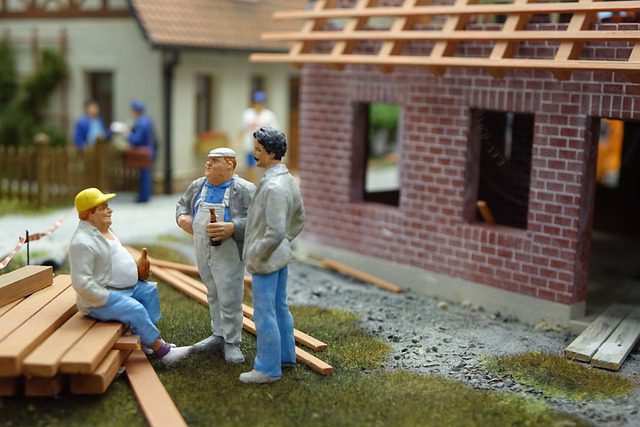
Sixty percent of the overall repair costs range from $900 to $2,300. $540 to $1,380 will be spent on labor, with materials accounting for the remaining 40 percent. A professional might be engaged to complete repairs at $45 to $75 per hour for labor.
If your style is out of the ordinary or the slope is steeper than average, your labor costs will rise. The repair process starts with visually inspecting the structure to establish the issue and the necessary repairs.
Then, they will negotiate a repair strategy, which may involve removing and replacing damaged components. Repairs aren't always necessary for the entire piece. The repair needed directly influences the project's cost and duration. Even the tiniest of repairs require at least two hours to accomplish.
| Project | Cost |
| Tile restoration | $300 to $600 and up to $6,000 to $11,000 |
| Tile replacement | $5.50 to $36 per square foot |
| Underlayment replacement | $0.50 and $2 per square foot |
| Roofing felt replacement | $0.50 and $1 per square foot |
| Synthetic roof underlayment | $0.75 and $2 per square foot |
Minor restoration projects, such as cleaning the gutters, might average between $300 and $600, depending on the size of your structure. However, a thorough restoration costs around $2,500 for an average property.
Prices might range from $6,000 to $11,000, depending on the scope of the work. Restoration is the process of extending your structure's longevity, offering you a cheaper option than a complete replacement.
Over time, tiles can be damaged by several factors, including extreme weather, infestation, or falling debris. This technique entails cleaning, repairing, or replacing any broken, damaged, or cracked surface. Protecting the surface with a clear coat prevents any further damage.
If the materials need to be replaced, you may spend roughly $5.50 to $36 per sq. ft. The replacement cost includes removing the current materials and discarding the old ones, underlayment, materials, and installation.
Although it can appear expensive to replace tiles, it is occasionally a more practical alternative than repair. If your anticipated price to repair is more than half the replacement price, you may want to consider a total replacement instead. Several positives to consider regarding a replacement, including having all concerns repaired at once.
If you opt to repair one area of your structure, another area might need repair later. Long-term savings are realized by having your structure repaired instead of replacing the existing one.
Depending on the material, replacing an underlayment costs between $0.50 and $2 per square foot. The underlayment between the tiles and the deck acts as a protective barrier, keeping the surface dry and free of leaks and damage caused by the elements.
Repairing or replacing a structure often necessitates replacing the old underlayment, especially if the structure is more aged. A robust underlayment protects your structure if damaged and can prevent many severe problems from developing, including leaks.
Underlayment is typically included in the project cost, but it never hurts to double-check.
Felt, commonly known as asphalt-saturated felt, has been a standard underlayment material for construction types for decades. The material is comparable to tar paper but combines polyester, cellulose, bitumen, and asphalt soaked in a waterproofing agent.
It costs between $0.50 and $1 per square foot to replace the felt underlayment, including the materials and labor. It's available in two weights: 15 lbs. and 30 lbs.
Compared to the 15-pound type, the 30-pound class is significantly thicker and more rigid. As a result, the 30-pound felt is an excellent option due to its resistance to damage from the elements.
It costs between $0.75 and $2 per square foot to replace synthetic underlayment, including supplies and labor. Underlayment should be replaced if damaged or exposed for an extended time. Professionals currently employ synthetic underlayment as their primary underlayment.
Compared to paper or asphalt, durable plastics like polyethylene and polypropylene are commonly used in synthetic underlayment. Exceptional strength, flexibility, and waterproofing characterize this underlayment, making it resistant to mold and other fungi.
This tear-resistant substance stays smooth and rarely tears around fasteners. It holds up nicely against UV damage and light.
As a result of its sturdiness and endurance to the harshest conditions, tile is a popular flooring choice for many homes. Maintaining and giving reasonable care to your structure is a must.
It should be checked at least twice or thrice a year or after a large storm or other weather events that could have caused harm. During the examination, clear the area of any debris and inspect the tiles, fasteners, and sealant. If there are any damaged sections, suitable measures should be taken quickly to reduce further concerns.
You should clean it any time you spot stains, mold, or mildew. Hand cleaning with a trowel and wire brush is the preferred method. Consult a professional if you aren't sure if you can handle it on your own. Avoid using high pressure on the structure.
This has devastating damage. Once your surface has been thoroughly cleaned, you can take additional steps to protect your building, such as polishing, priming, painting, or resealing to keep it in good condition.
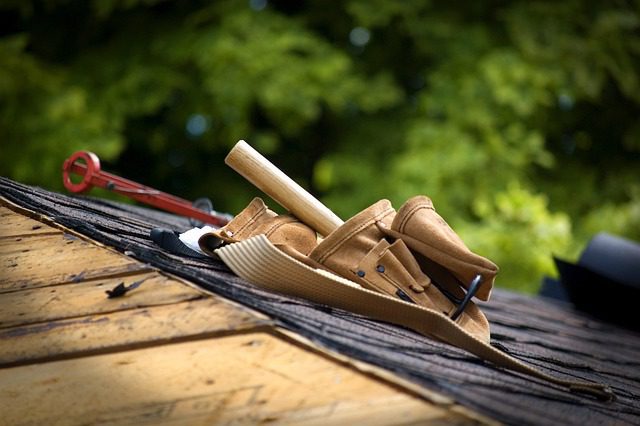
| Project | Estimate cost |
| Removal of a Roof | $0.50 to $1.5 per square foot |
| Tile painting | $2,550 to $4,250 |
| Roof support | $300 to $5,000, $500 to $5,000 (Truss replacement) |
| Roof Inspection | $100 to $600 |
| Tile cleaning | $0.30 to $0.75 per square foot |
Removing a roof might cost anything from 50 cents and 1.5 cents per square foot. You can anticipate paying double this cost for structures with more than one layer of tiles.
2. Roof Tiles Paint Prices
Typically, painters charge from $2,550 to $4,250 for painting. The amount varies depending on the region, the materials, the type of structure, and the materials' condition.
3. Roof support
Supports are a vital feature of any structure that maintains the structure stable and prevents it from collapsing or warping over time. A support problem can cost $300 to $5,000 in repair costs, depending on the nature and extent of the problem. If you need complete trusses replaced, those range from $500 to $5,000 to be installed.
4. Inspection of the Roof
The average fee for an inspection is between $100 and $600. Size, material, pitch, and present condition all influence this pricing. An inspection assesses the structure's condition and lifespan and any necessary repairs or replacements. An assessment is vital in finding potential problems and solutions to concerns.
5. Tile Roof Cleaning Cost
Roofing is exposed to several elements and severe weather. It is inevitable that debris, staining from food or drink, mold, and algae may accumulate over time. This can cause long-term damage and issues if it isn't cleaned. Cleaning services cost, on average, $0.30 to $0.75 per square foot across the country.
6. Additional considerations and expenditures
Purchasing new tiles is more expensive than repairing existing ones, but this is not always the best option. The labor cost will depend on the amount of damage and work.
The cost of cleaning up and removing any old tiles and materials should be factored in. If the problem isn't fixed, the roof and the house's contents risk further harm. Taxes and permit fees are not included.
Most of the time, residents in Arizona may be oblivious to the areas that are prone to roof leaks when designing and building a roof. Changing roof slopes meet in a roof valley with a name that stems from the roof's valley-like appearance, preventing water buildup on the roof.
The roof valley helps the roof slope drain water and reduces snow and ice accumulation on roof liners while at the same time improving the home's appearance. Complex roofs with multiple pitches will have dead valleys that must be protected and maintained.
A dead valley is a place on a roof where water cannot easily run down because of two slopes or a slope and a wall. Dead valleys can cause leaks and other roof damage if not properly maintained.
Good home designers who understand roofing and water movement avoid dead valleys in their blueprints, but when this is neglected, a roofing company must find and safeguard vulnerable areas. Where two roof slopes meet, a trough allows water to flow readily down the roof, but if the configuration is not designed well, water flows directly into these pitch regions, which have inadequate or no drainage.
When opposing roof slopes meet in a dead valley, there is little or no fall, leading to water and debris collection. Water generally drains fast, but in a dead valley, it can't because of the valley's flatness.
It can also occur when a roof section meets a lower outside wall. First, a regular valley runs into a flat wall corner instead of off the roof. Second, two or more slopes merge into one.
Low-sloped roofs should use materials that can endure water runoff without early deterioration. Roofing contractors often shingle over these sections without the proper underlayment, costing homeowners hundreds in repairs.
Debris and water can deteriorate wood and shingles, causing costly repairs. Dead valleys on roofs collect rainwater, snow, leaves, and other detritus, and as the roof ages or disintegrates, debris and water will leak through the shingles.
Dead valleys become an issue for roofers as leaking spreads, and the roof structure decays. When serious damage is long-lasting, the roof and adjacent structural components may need to be replaced.
Even if you can remedy a dead valley, it will limit your roof's lifespan if you do it too late or with the wrong method. Builders and roofers often "solve" a flat area by laying shingles and felt paper.
Despite their thoughts, a bad solution like this will leak in three to five years. It may lead to:
Leaks:
More roof leaks may indicate an unknown dead valley. Most homeowners don't know they have a dead valley roof until a leak is discovered, but that doesn't imply the situation is irreparable.
During roof repairs, membranes and other solutions can avoid water pooling and damage.
Roof water and debris collection:
Stagnant water is a common cause of leaking roofs, but it's not the only problem. Pooling water causes issues and can attract bugs.
Rooftop puddles attract mosquitoes because they provide ideal nesting conditions. Water seeping through the roof also attracts cockroaches and termites.
Standing water can cause expensive repairs and create ecosystems that should be avoided.
Ice dams:
Ice dams can cause substantial damage and leaks even when water appears to be flowing. Ice dams can create dead valleys where none existed previously.
A roof ice dam prevents melted snow from draining off the side. This can promote mold and mildew growth. Repeated freezing and ice thawing can cause considerable roof cracking and paint blistering and peeling.
Rot and moss:
Vegetation can develop in even the slightest roof breaches, creating a concern. Roofs with moss, algae, or weeds are less water-resistant, making them more vulnerable.
Roots can break roof membranes, enabling water to accumulate and attracting more pests.
A roofing system is a big investment for property owners, and represents a big portion of construction costs.
It’s a roofing contractor’s job to help the owner protect their investment. They should provide professional, careful maintenance on the roof on a regularly. This will make sure its properly protected.
Here are some tips that will help your roofing contractor ensure they won’t miss any essentials during services. If you’re a homeowner, these tips will guide you on what to expect when you hire a professional roofing company to perform routine shingle roof maintenance.
A roofer should perform 4 basic services twice per year to help a homeowner properly maintain their asphalt shingled roof. Also, you’ll want to do this after major storms. Here’s your roofing maintenance checklist:
A critical part of roof maintenance is routine cleaning and clearing of the roof and its related systems. Pay attention not only to shingles and flashing but other key elements, like eaves, troughs, down spouts, installations (such as skylights, vents, chimneys, solar panels), and ventilation.
Here’s what we recommend:
Property owners should regularly clear debris from the roof, including leaves, branches, and other items that might clutter the surface. Your roofing contractor might use a leaf blower, being sure to blow the air down the roof. This will ensure that debris won’t be blowing up and underneath the shingles. To lower the debris that accumulates, clear away vegetation and branches that hang over the roof. Hire a professional tree service to cut away difficult or hard to reach areas.
Dig out leaves and organic material from all gutters. This will ensure water drains without obstruction through to the downspouts. Homeowners could install eave protectors, metal meshed grates that prevent buildup of debris and make cleanup easier.
Be sure the downspouts are clear and unobstructed so water drains properly from the roof and away from the foundation. A homeowner should take notes of any leaks or drips that occur during or right after a rain storm. Report any issues to the contractor during inspection time.
Once cleared of debris, your roofing contractor should inspect it for any red flags that could indicate potential trouble.
They should complete this inspection twice a year – recommended in the spring and fall. This will allow them to make note of anything suspicious, as well as complete small fixes or minor repairs before they become bigger issues. Also, they’ll see if there’s any evidence the ventilation system is malfunctioning or might need maintenance or cleaning.
An experienced roofer should immediately complete any asphalt shingle roof repairs to maintain the integrity of the roof’s materials and related systems, such as drainage and ventilation. Little fixes performed properly will prevent bigger issues, or more costly repairs, over time. They could:
Replace or repair missing, broken or buckled shingles: A roofing contractor could use roofing cement or nails to repair shingles that have become cracked or loose. They could also replace any shingles that have broken free or blown away.
Replace or install valley flashing: They may also consider replacing the existing valley flashing if its become corroded, cracked or is no longer secure – which would threaten its waterproofing abilities.
Replace other flashing: Your roofer could use roofing cement and nails to replace metal flashing around chimneys, roof vents or other installations if the flashing has become loose or rotten. If they’re installing the flashing against a brick structure, it’s advisable to use copper or galvanized steel, because the lime in brick mortar could corrode aluminum materials.
Repair gutters or downspouts: Your roofing company might use gutter caulking, a gutter patching kit or roofing cement and patches to fix leaky or corroded sections of the eavestroughs or downspouts. If they are sagging, they should use a level to determine the proper pitch, then rehang them so they drain properly.
Whether you’re a homeowner looking to maintain the life of your roofing system, or a roofing professional educating your customer on the benefits of regular inspection, maintenance and repair, sticking to a consistent, regular schedule is well worth the investment.
We only think of them when there’s a problem, and we only replace them when we have to. But, when we do maintain them regularly, we can extend their useful life. It doesn't matter if you have a tile, shingle, flat roof, or foam roof it must be maintained.
We also need to make sure that our roof receives the proper maintenance to increase its useful life.
Guaranteeing roof life starts with regular inspections. The National Roofing Contractors Association recommends inspecting all roofs twice a year: once after the coldest temperatures, once after the hottest temperatures. It’s also always good to scrutinize your roof following any major weather occurrence.
Establishing a schedule for routine, professional roof inspections should be a priority for property owners. Inspections are cheap and can provide critical information that can prevent expensive repairs later.
Also, regular roof inspections provide a checklist for routine maintenance work and enable owners to prepare budgets for the future. Roof inspections are the first step in a roof maintenance program that can help owners plan and schedule repairs instead of having to do expensive emergency repairs.
Few other property maintenance tasks provide a better return on investment than regular roof inspections.
Before the monsoon season gets started, call a recommended roofing company and have your roof completely inspected. The roofing contractor will look for signs of any loose or missing shingles or tiles, gaps or cracks around any flashings, also check for deterioration in sealants or the underlayment.
Any problems can make your roof susceptible to the strong rain and wind that come with the storms
If your roofer finds any issues or signs of potential problems during the inspection, have the repairs taken care of before the monsoon season picks up.
You will be making sure your roof is in the best shape possible to fight off tears and cracks that can lead to moisture leaks. Make sure any loose tiles or shingles are fastened or replaced.
Update the seals around flashings and other roof elements. Make sure that your roof is strong and provides a strong barrier between your home and the coming violent storms.
Leaks after heavy rain are one of the primary reasons roofs should be inspected. But a leak is only a sign of a problem that might have been building over time.
If you’re looking for a silver lining, a leak can actually be good news. Without evidence of a roof leak, a lingering problem of undetected water infiltration could continue to create hidden deterioration, such as rotting wood, mold, wet insulation, or corrosion.
It takes an experienced professional eye to conduct a thorough leak investigation and diagnosis because the entry point for water might be quite far away from the detection point. Leaks can be evidence of serious roof problems or minor issues.
Many roofs in excellent condition occasionally have issues due to minor flashing problems.
Few features are as important to roof performance as proper slope and drainage. Water standing on a roof increases the chance of leaks and water infiltration significantly. Making sure you have good drainage is a very important reason for regular roof inspections.
Leaves, trash, debris, and other objects can clog or obstruct roof drains, creating standing water. Regular cleaning of roofs can help remove such problems and allow water to drain properly, which reduces the chance of leaks. Also, water is heavy – weighing about 5 pounds per square foot per inch deep.
Poor drainage also causes deterioration of roofing materials, leading to a shorter life of the entire roof system.
If a leak occurs from standing water, insulation can get saturated over a wide area, which could require entire roof replacement.
Vegetation can grow on roofs when gutters and other low areas aren’t cleaned on a regular basis. Birds can land and nest on roofs.
They also deposit seeds, which will promote the growth of vegetation. Gutters are a particular source of problems because of the accumulation of dirt, seeds, and water. In addition, tree branches scraping on roofs during wind storms can cause serious damage.
Gutters should be cleaned regularly, and trees near your roof need to be trimmed to prevent contact with roof surfaces.
Many owners pay for repairs themselves that would be covered under a contractor or manufacturer’s roof warranty.
Leaks can be caused by a lot of things, only some of which are covered under a warranty. However, when a leak is found, you should have a qualified person perform an inspection to determine whether or not to file a warranty claim.
When a roof warranty claim is filed, the contractor or manufacturer will visit the property and make an assessment of whether the leak or repair is covered. The important thing for the property owner is keeping possession and ready access to the warranty paperwork, as well as timely filing of the claim.
There are a variety of ways that weather can incur damage to your roof, even in moderate storms. When a storm has passed, the absence of leaks doesn’t guarantee the roof is undamaged. Whether the storm brought rain, wind, and/or hail, doing an assessment quickly can start the repair process before more damage incurs.
The most dangerous residual effect of high winds is downed power lines, so look for those first. Make this assessment from as far away from the lines as possible for safety purposes. Report any issues to your electric utility immediately.
Many areas of a roof may not be visible from the ground, but if you have trees that are missing branches that can’t be found, they may be up there.
Many leaks start small and grow over time. You may not see water damage unless you’re up in the attic. Look for damp insulation and inspect the areas around the chimney, the vents, and any other apparatus that penetrates the deck.
Take a walking inspection around the grounds of your home. Look for all types of roofing materials including shingles, fascia, and flashing that may have been blown off of the roof. Take a look around the mouths of all of your downspouts as well to see if any roofing materials came loose and were carried down by the drainage system. You may also be able to assess any separation of the shingles from the deck by inspecting the roof’s edges, which can be caused by storms with high winds. Remember that finding one broken shingle on the ground may mean that there are many more broken pieces that evidence roof damage repair that are still on the roof.
When Summer is here and the monsoon season approaches, Arizona residents need to be wary of the many roofing scammers that invade our communities. Finding a reputable roofing company can be hard enough without having to worry about being ripped off. Be diligent and wary of contractors that present themselves as professional roofers, but don’t have the proper insurance or credentials.
Here’s an example of a roofing scam that bilked 27 homeowners in Texas out of thousands of dollars: Texas roofing scam. In the case these individuals stole over $100,000 from unsuspecting homeowners by approaching them after storms. They took advantage of people desperate for repairs. They even sometimes brought their baby along to convince owners they were trustworthy and eager to work. A little research by the homeowners would have shown them that this company had an F rating with the Better Business Bureau and were ignoring many complaints registered with them instead of answering and solving them.
So, what are the best ways to watch out for roofing scams? First, make sure you do your homework on any contractor before hiring them and especially before giving them any kind of money for doing the work. Request that they present their contractor’s license and check their standing with the Registrar of Contractors. Ask how long they’ve been in business and verify their answer online. Check if they have a solid website that shows they’re legitimate. Look and see if they have a listing on any of the consumer sites like Yelp, HomeAdvisor and Angies’s List and check their testimonials and ratings there.
Also, make sure you check that they have the proper insurance in place. The worst thing you could do is contract with someone without proper insurance, then have them have an accident or damage your home, leaving you with extensive medical or repair bills without coverage. You can see a previous blog post we wrote on this subject here: Roofer’s Insurance.
Finally, ask for references from satisfied past customers and call them to verify that they were happy with the roofing contractor’s service, communication and timely completion of the job.
Is your roof ready for the heat? Phoenix has a lot of wonderful attributes, but the searing Summer heat isn’t one of them. Not only do we have intense heat but the monsoon storms can be extremely intense with strong winds. Combine these two and there’s definitely a yearly threat to the condition of your roof. It’s extremely important that you prepare your roof so that it might survive the weather with minimal damage.
Tall trees near your house can cause damage to your roof when swaying or falling during summer winds. At the least, they could cause leaks in your roof, but if the branches are big enough, one could literally crash down right through it.
When planting new trees, don’t plant too close to your home and with existing trees, hire a professional tree trimming service to clear away any branches that might have the potential to cause damage to your roof before the storm season starts. Trees that look unhealthy or might be dead should be removed. They could snap off at the trunk in a strong wind and threaten to crash down on the house.
If you have gutters and/or downspouts, make sure they are clear of debris before the monsoon season begins. If they’re clogged, they wont be able to divert water from heavy rains away from your roof and foundation, which could lead to water pooling on your roof, or near your home, potentially causing damage to shingles, tiles flat roof systems and your foundation.
Before the monsoon season starts is the perfect time to get your roof inspected by a professional roofing company like Mikku and Sons Roofing. Your roof may have cracked shingles, damaged or misplaced tiles, and possible underlayment damage caused by last year's storms that you don’t know about. If these exist, you could have more damage and roof leaking from the new season’s storms.
It will give you an opportunity to make any necessary minor repairs before the storms turn them in to major ones. You don’t want to learn the hard way that you have some previous damage in the middle of a major storm that causes water to start pouring through your ceiling.
Not only can our extreme heat be tough on your roof, it dramatically increases your cooling costs. If you have an older roof, you might want to think about a phoenix roof replacement and go to a cool roof system. These types of roofs are designed with materials that do a better job of reflecting, absorbing and redirecting heat to help keep your home cooler and your air conditioning bills lower. They can also be coated or painted with insulating materials that help with this task. Give a professional roofing company a call to discuss your options here.